On a residential construction budget, “What should you Not scrimp on” is a title for this online article that was suggested by a possible client. This is a new feature we are considering offering on our new website format, coming soon to a computer near you.
Your House Project & What You Should NOT Scrimp On
 Let’s call our client Marsha (that’s not really her name). She and her husband have purchased land somewhere in the East Central USA. It could be anywhere. Her family is budget-conscious. They, like all people considering the design and construction of a custom house, want more house and features than they are willing to spend. We see this a lot. It applies to people from all walks of life and all sizes of houses. So, this is not unique to any particular size or residential budget sector. We all have in common: we want more than we are willing to spend to provide. We have found this to be the case with retired working middle-class citizens, millionaires, billionaires and everything in between. It seems to be a human characteristic that we all want something better. The issue now is: what are the most important things?
Let’s call our client Marsha (that’s not really her name). She and her husband have purchased land somewhere in the East Central USA. It could be anywhere. Her family is budget-conscious. They, like all people considering the design and construction of a custom house, want more house and features than they are willing to spend. We see this a lot. It applies to people from all walks of life and all sizes of houses. So, this is not unique to any particular size or residential budget sector. We all have in common: we want more than we are willing to spend to provide. We have found this to be the case with retired working middle-class citizens, millionaires, billionaires and everything in between. It seems to be a human characteristic that we all want something better. The issue now is: what are the most important things?
Okay. This being the case, Marsha wants to know: on what items should I NOT think about economizing? Good question. If you turn the budget monster loose, it can devour everything in its path, leaving you with a tract house. That is not the objective. The idea is to know what things are Core Value Items that should be regarded as sacred.
And so what kind of items would these be?
1. HAVE YOUR HOUSE DESIGNED BY A LICENSED ARCHITECT = great design quality.
2. ENERGY EFFICIENCY = lower utility bills, healthier house, lower carbon footprint.
3. QUALITY OF CONSTRUCTION MATERIALS = things that are impossible or expensive to change later.
4. FUTURE ADDITIONS/RESERVING SPACE FOR POSSIBLE FUTURE IMPROVEMENTS. This costs next to nothing. It is part of item 1. and can be priceless for future convenience. It can save your project. consider an approach that allows future additions for more Bedrooms, Bathrooms and recreational spaces. Especially if your budget-crunching shrinks the original house. This is a creative approach that could save many people’s projects. It really does not have to be “all or nothing.”
5. LARGE GLASS AREAS = for your doors and windows. Expensive to add later.
6. NICE LARGE KITCHEN. Expensive to add later.
7. MAIN CORE AREAS: Living-Dining-Kitchen, Master Suite.
—————————————————————————–
Now let’s take a look at each of these items in some more detail.
1. HAVE YOUR HOUSE DESIGNED BY A LICENSED ARCHITECT

By having a licensed architect design your residence, you are using the most skilled professional on the planet to conceive your house. No one is more prepared to do this than someone whom has gone to major universities to learn how to design, apprenticed for about a decade, similar to doctors, taking grueling board exams, gone through the licensing process and continues to take yearly continuing education programs to remain knowledgeable with the latest technologies and best practices.
A real architect will create a house that will amaze and delight you. It will be efficient, using every square foot to good purpose, orient on your land’s views, and have the spaces and sizes you need to comfortably accommodate your desired lifestyle. No one else can do this as well as a licensed residential architect. Hire one to help you do this.
2. ENERGY EFFICIENCY

This is Not a place in which to scrimp, within certain parameters. Why? Because you will be paying your power company for your decisions about this for the rest of your life (assuming you live in this house for the duration of yours). And with rising fuel costs during your lifetime for your vehicles, do you suppose that you can count on your electrical power to decrease or increase? Silly question, right? Of course, your power cost will continue to escalate. So, the lower you can make your consumption, the lower your monthly power bill will become, right? Therefore, you want your architect to design the most energy efficient “building envelope” for your house possible.
There are expensive materials for this and downright cheap ways to accomplish this. The best way is also the most expensive: using polyurethane liquid spray foam inside your walls, floors and roof. It will fill every crack and crevice and yield the highest “R” value possible (the relative Resistance to heat gain or loss from your house’s interior to the exterior environment). Unfortunately, this method can cost you anywhere from 7x to 4x greater cost than the equivalent R value using fiberglass insulation (the pink or yellow fuzzy stuff that makes you itchy). Okay, so why not just use only fiberglass? Well, it turns out that fiberglass does not do a very good job of keeping out “infiltration.” Infiltration is outside air coming into your home or inside conditioned air leaking to the outside, in an uncontrolled manner and in unplanned locations.
How to correct this in an economical manner? Contact Rand Soellner, ArCH/NCARB at 1-828-269-9046 or Rand@HomeArchitects.com to find out. We do it every day, using an unorthodox approach that saves tens of thousands of dollars for similar results and with higher R values.
And there are other things than just insulation affecting Energy Efficiency. Door, window glass selection and roof overhangs and site orientation, nearby trees, roofing materials and more.
3. QUALITY OF CONSTRUCTION MATERIALS
These are things that are impossible or expensive to change later. Your Doors & Windows. Roofing. Siding. Paint. And much more. Your architect can help you evaluate these options. There is much to consider. For instance, if you want wood floors, you can have them. Do you have to have heart pine, which may cost you from $11 to $14/sf (Square Foot), or can you live with #2 SYP (Southern Yellow Pine)? The later is a softwood, but can actually look fine, if pre-distressed so further marks won’t be noticed ($0.99/sf+/-). Over a 2,500 HSF (Heated Square Foot) house, this can amount to a $32,000 difference! See your architect for counsel on this and more choices. You may have started out your project insisting on slate roof tiles. After discovering that this expenditure might make the difference of your eldest child attending college or not, you may consider other options. It all depends on your financial circumstances, pressures and desires. But choose well, considering all of the options. Do not allow preliminary feelings like “I just love stone. I’m going to make my house all out of rock!” skew the reality of what you want to pay for what features. That choice, for instance, could impact your new house cost by as much as $100,000 or more! Judicious use of certain materials and features can help you control your costs and your architect is a master at helping you prioritize where to use the “good stuff.” A careful, surgical and laser-like use of certain materials and details can give almost the same impression as the Peanut Butter approach (where you smear expensive materials everywhere, indiscriminately). Your residential architect knows how.
4. FUTURE ADDITIONS/RESERVING SPACE FOR POSSIBLE FUTURE IMPROVEMENTS

This is really not so much something to not scrimp on and a major safety valve for you. There is nothing so powerful in a construction project as cutting square footage and size. More space = more materials = more cost. If you really don’t need 5 bedrooms or even 3 right now and your budget is that tight, consider postponing adding that space later. Your project size will shrink and so will its initial construction cost. 1,800 sf usually costs less to build than a 3,500 sf house, assuming the level of detail and quality and space is similar for both.
For instance, your architect can plan the entire future build-out, but then indicate that certain portions, say for instance a garage, will Not be built in the original effort, but probably will be added at some future date. This type of fiscal + building phasing is quite normal in commercial projects, and some architects can bring this level of understanding and fiscal planning to bear on your house project, to help you save tens of thousands (or hundreds of thousands) of dollars for your initial residence.
As an example, we spoke to a gentleman from Africa today, who owns land on the coast of Cameroon. He wants to ultimately have a 3,500 HSF house, but only wants to invest enough money to build a much smaller house. So, we proposed that he have us design the whole house, but also prepare a Phase 1 that will be about 1,000 HSF. This will have a 2-story volume open plan concept that will house his Living, Kitchen and Dining space. Attached to this will be another 2-story block, with a Master Suite on the ground floor, and a home office above this on the 2nd floor, which can also serve as guest bedroom. As the newlyweds’ family grows, they can add bedrooms and bathrooms on the other side of the house, along the opposite side of the central 2-story cathedral space. They had never thought of such a creative approach. This is going to work well. There may be other factors in your specific neighborhoods related to building minimum square footages, so be sure to research that well, before buying your land, so that you are Not trapping yourself into building a large size initial home than you want to spend to construct.
5. LARGE GLASS AREAS
This is mainly for your doors and windows. These items are expensive to add later. Better to keep these in your architect’s design. They will be worth it. This is one of the sacred paybacks to yourself for getting this far in life. You deserve it. Enjoy. You paid a lot for your land with the great view, so allow your architect to capture those wonderful views with your house.
6. NICE LARGE KITCHEN
Very expensive to add later. Plumbing, electrical wiring, appliances, finishes, cabinetry and countertops: a kitchen renovation can easily cost from $30,000 and go up from there. Do it right and do it in the original. Do Not fall for the label game for your appliances, however. You can get about the same look for a fraction of the cost sticking to leading brands, rather than going for the high-end luxury “names.” When you are considering paying $8,000 for a refrigerator that has about the same look and nearly the same size as one from another manufacturer for $1,200 you will understand what we are talking about. Appliances can kill your budget and you can change many of those out later, if you really want to do so, as long as you have the space required. So, within reason, let your architect provide you with a great design for your kitchen and is spacious and works well. Just do not get carried away with high-end appliances. Those can kill your budget. They all pretty much heat the same and cool the same, grind the same and drain the same.
7. MAIN CORE AREAS
These are your: Living-Dining-Kitchen, Master Suite. These are the main spaces that you use everyday. If you also have a home office somewhere, that can be considered part of your core spaces. Core Spaces are the ones in which you spend the most time. They deserve your biggest investment. The main open plan space typically includes a big room into which your residential architect arranges your Kitchen, Living and Dining. They are typically all together in the most functional designs, to give a feeling of more spaciousness. This feels larger than more compartmentalized designs, because it is! Make it nice! High ceiling, nice kitchen (see item above), big glass for the views (see other item above), nice flooring and a few details here and there. You will likely never change anything here, so do it right. However, the one thing that you can add is: finishes that can be applied over initial finishes. For instance, if you start out with gypsum board for your walls (“drywall”), with paint, you can, at some point in the future, install wood over this, as long as you find the studs and sink nails into them through the new materials. So, if you really want lots of wood siding in your new home, but your budget is scaring you, considering postponing that wood into the future. Not a problem.
Your Master Suite is sort of your holy of holies. Here is where you sleep, make love, bathe, groom and dream. View is important. Access to an outside porch would be nice, but this outside work could possibly added in the future to save costs on the initial house. Hot tubs and the like are nice, but can take up a huge amount of space. Garden tubs (perhaps 3′ x 6′) should be included at the least, for resale. Beware of only providing a shower in the Master Bath. My wife is a real estate broker and has a hard time selling homes whose Master Baths are this skimpy. Whether or not you use it is not the point. You could be shooting yourself in the foot as far as a future resale is concerned. Do not be too skimpy with space or counters or sinks or windows or height in the Master Bath. Can your see out to some nice trees at least? Good. Think of yourself as a potential future buyer walking through your house! Would it appeal to you on that basis? Nice tile: important. Nice fixtures (not chrome) are important. Adequate towel bars and places to hang bathrobes, washclothes and the like. A privacy alcove for the toilet. It just isn’t nice to expose the toilet in the main room. Women hate that. Having 2 separate vanities or at least one long one with at least 2 sinks (His & Her). Space. Room to move without bumping into things.
————————————————————-
Okay, now how to accomplish all of the above, because you are not a designer? Easy: hire yourself an accomplished licensed architect who specializes in residential designs. Maybe someone who has been featured in books and magazines. Someone whom you would be proud referring to, during resale.
And if you are very eager to proceed, consider contacting: Rand Soellner of the Home Architects ®. www.HomeArchitects.com
tags: residential design, Atlanta, Houston, Dallas, Canada, Las Vegas, Aspen, Telluride, Hendersonville, Cashiers, Highlands, Lake Toxaway, Newnan, Orlando
